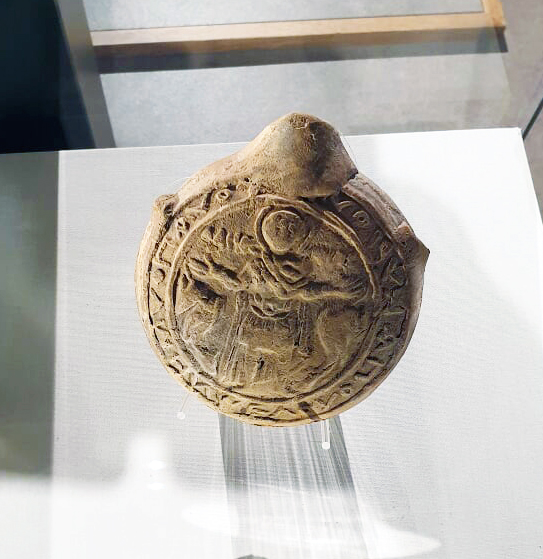In the museum at Norton Priory, just outside Runcorn, there is an important and visible reminder of the ancient connections between Britain and Egypt. The monastery houses a collection of pilgrim tokens, and among them is a pilgrim flask from the monastery and shrine of St Mena in Egypt. It can easily be recognised by the figure of St Mena with his two camels. It was excavated in the area around Norton Priory and Runcorn. Another pilgrim flask from the monastery of St Mena in Egypt was found a few miles away at Meols on the Wirral where there was once an ancient trading port which received and sent ships as far as Egypt and the Eastern Mediterranean.
This second locally discovered flask of St Mena is in the collection of Chester Museum. The flask was excavated in the tide-washed muddy beach which was once the site of an ancient settlement but has now been covered by the sea. Until recently the trunks of old trees could still be seen. Other finds there show that it was a major trading root with the Eastern Mediterranean, as far as Egypt. We also know from Eastern historical texts that ships sailed from Alexandria as far as Britain.
These are not the only pilgrim flasks from the shrine of St Mena which were brought to Britain. Others have been found, which show that even in the 5th to 7th centuries there were British people visiting the Middle East, and seeking the intercessions of St Mena at his shrine, and there were Christian traders coming from Egypt and making their way to the islands at the edge of the world, even to the Wirral and to Runcorn, 1500 years before the Coptic Orthodox Church of St Mary and St Mina was consecrated in the same part of Britain.

This is a tangible connection with Egypt and the Coptic Orthodox Church in ancient times. Someone had brought this from Egypt. Either a Coptic Orthodox Christian visiting Britain to trade other goods, Or a British Christian had visited Egypt himself and venerated St Mena at his shrine before returning to Britain. These flasks were produced between the 4th and 7th centuries, after which period travel became more difficult in Egypt because of the Islamic conquest. This was a period in which the Christians of Britain were also Orthodox and Catholic in their faith and practice.
Who were these travellers, these pilgrims, who had visited Egypt from the British Isles. Perhaps their distant descendants still live in the North-West of England, and now have the opportunity of visiting a Coptic Orthodox Church in Manchester themselves, where St Mena is still honoured.
All around us in the British Isles, there are such holy places, reminding us of holy people, who lived and prayed and worshipped where we now live. As Coptic Orthodox Christians who have made a home here in the British Isles, and as British people who have made a home in the Coptic Orthodox Church, these holy people and holy places of the British Isles must become known to us, and valued by us, if we wish to be blessed by the prayers and intercessions of the saints of these lands, and by God who glorifies himself in them.
